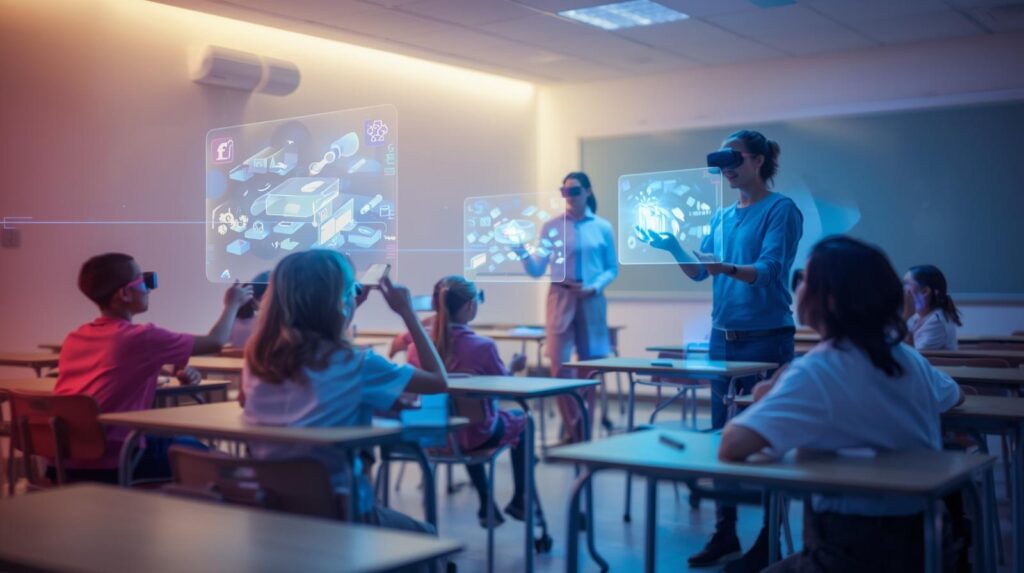The educational landscape is undergoing a significant transformation, driven by technological advancements. Among these innovations, augmented reality (AR) is emerging as a powerful tool in reshaping how we teach and learn. By seamlessly blending digital content with the real world, AR offers a new dimension to education that is both engaging and enlightening.
Augmented reality in education refers to the integration of digital information with the user’s environment in real time. Unlike virtual reality, which creates a fully immersive experience, AR overlays digital content onto the real world, enhancing what we see, hear, and feel. This technology is particularly effective in classrooms, where it can bring abstract concepts to life, making them more tangible and easier to understand.
The use of AR in education is not just a futuristic concept; it is already being implemented in various educational settings around the world. This trend is driven by the growing accessibility of AR technology and its potential to enhance learning outcomes. According to recent studies, schools that have integrated AR into their curriculum have seen improvements in student engagement, motivation, and retention of information.
One of the primary benefits of AR in education is its ability to capture students’ attention and foster interaction. Traditional teaching methods often struggle to engage digital-native students who are accustomed to interactive and multimedia-rich content. AR addresses this challenge by providing immersive experiences that make learning more engaging and enjoyable.
For example, AR can transform a simple biology lesson into an interactive exploration of the human body, where students can visualize organs in 3D and understand their functions in real time. This hands-on approach not only makes learning fun but also enhances comprehension and retention.
AR technology can also support personalized learning by allowing students to learn at their own pace and according to their individual needs. With AR, educators can tailor content to different learning styles and levels of understanding, providing a customized educational experience for each student.
For instance, AR applications can offer additional resources or alternative explanations to students who need extra help, while allowing advanced learners to explore more complex topics independently. This adaptability fosters a more inclusive learning environment where every student can thrive.
AR in education bridges the gap between theoretical knowledge and practical application. By allowing students to interact with digital simulations of real-world scenarios, AR helps them apply what they have learned in a safe and controlled environment.
For example, in engineering courses, AR can simulate machinery operations, giving students a chance to practice and hone their skills without the risks associated with real machinery. This experiential learning approach not only enhances understanding but also prepares students for real-world challenges.
While the potential of AR in education is immense, there are challenges and limitations that must be addressed for its successful implementation.
One of the main challenges is the cost associated with implementing AR technology in classrooms. Schools need to invest in hardware, such as tablets or AR glasses, as well as software and applications that support AR experiences. For many educational institutions, especially those with limited budgets, these costs can be prohibitive.
Additionally, the integration of AR technology requires reliable internet connectivity and technical support, which may not be available in all schools. These technical barriers can hinder the widespread adoption of AR in education.
For AR to be effective in classrooms, educators must be adequately trained to use the technology and integrate it into their teaching practices. This requires not only technical training but also a shift in pedagogical approaches to fully leverage the capabilities of AR.
Moreover, the curriculum needs to be adapted to incorporate AR experiences, which can be a time-consuming and complex process. Educators must collaborate with technology specialists to develop content that aligns with educational standards and learning objectives.
Despite the challenges, the future of AR in education looks promising. As technology continues to evolve, we can expect AR tools to become more accessible and affordable, paving the way for their widespread adoption in classrooms.

Several emerging trends are likely to shape the future of AR in education. For instance, the development of AR platforms that allow educators to create their own content could democratize the use of AR, making it easier for schools to implement the technology.
Furthermore, advancements in artificial intelligence (AI) could enhance AR experiences by providing real-time feedback and adaptive learning paths for students. This combination of AR and AI has the potential to revolutionize education by creating highly personalized and dynamic learning experiences.
To fully realize the potential of AR in education, collaboration among various stakeholders is essential. Educators, technology developers, policymakers, and industry leaders must work together to address the challenges and explore opportunities for innovation.
By fostering partnerships and investing in research and development, stakeholders can create an ecosystem that supports the integration of AR in education and drives its growth.
Augmented reality is transforming the way we learn, offering new possibilities for engagement, interaction, and personalization in education. While challenges exist, the potential benefits of AR in classrooms are too significant to ignore.
As we continue to explore the capabilities of AR, it is crucial for educators, policymakers, and technology leaders to collaborate and innovate. Together, they can shape the future of education, ensuring that it remains relevant and effective in a rapidly changing world.



